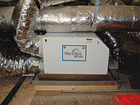
A properly sized air conditioning system will help manage humidity levels, but over sizing can have adverse effects.
For some time, energy efficiency and IAQ were thought to be mutually exclusive HVAC goals. They actually can have negative or positive effects on each other that can be mitigated by contractors in a number of ways: coil care, duct repair, and the judicious use of specific equipment among them.
Neither poor IAQ nor low operational efficiency occurs in a vacuum. A recent trend has been linking the impacts they can have on each other.
BEYOND ALLERGIES
“The trend is towards integrating IAQ practices into building operating and maintenance procedures,” said Nitish Singh, director of marketing and product development, Rheem Manufacturing Co., A/C Division. Customers who see the value in an IAQ system “recognize the improved health benefits and comfort that come from it.Contractor Steve Lauten, duct-repair proponent and president of Total Air & Heat, Plano, Texas, pointed out some hard truths. “I think awareness between air quality and energy efficiency is increasing, but at too slow of a rate. I hold contractors responsible to a large extent because they tend to do what’s easy. In the summer, they sell a high-efficiency system and connect it to a low-efficiency, existing duct system.
“The reality is, the HVAC industry could have the biggest impact on improving the environment if it would simply take a stand: fix duct systems before replacing equipment,” Lauten said. “In the process IAQ, efficiency, and comfort are dramatically increased.”
“We definitely see an increase in consumer awareness on the connection of IAQ and energy efficiency,” confirmed Joe Hlavacek, business development manager for Ultra-Aire, a manufacturer of whole-house ventilating dehumidifiers. “In some cases, consumer awareness seems to be greater than HVAC contractor awareness.” The consumers do plenty of online research.
Contractors may need to expand their knowledge base, he said, and be prepared to teach customers about how better windows and insulation can affect the home’s ability to expel VOCs, or maintain proper humidity. “Consumers need to be educated on the proper choices for their homes,” Hlavacek said. “Providing a solid foundation of facts is a great starting point.”
“Most people realize that treating the outdoor air that enters a building is expensive, but that it’s necessary to maintain good IAQ,” said Christian Taber, senior applications engineer with Big Ass Fan Co. “It isn’t a huge jump from there to understanding that an energy efficiency measure (EEM) that reduces the amount of outdoor air entering a building can have a negative impact on the IAQ. However, the magnitude of the impact is sometimes difficult to quantify, and not all EEMs have a negative impact on IAQ.”
“Air quality is mostly an abstract thought to the typical homeowner, unless someone suffers from asthma or allergies,” said Chuck Applebee, product manager, Mitsubishi Electric, a manufacturer of ductless comfort products. “Homeowners generally first consider mechanical solutions to provide room air filtration, and the idea of outside air ventilation is secondary, if it’s considered at all.”

“The HVAC industry could have the biggest impact on improving the environment if it would simply take a stand,” said Steve Lauten.
WHAT THEY NEED TO LEARN
“Controlling how, when, and where the outdoor air enters the building (ventilation vs. infiltration), pretreating outdoor air with some sort of energy-recovery device, and maximizing the air distribution efficiency of the HVAC system can provide high IAQ and high energy efficiency,” said Taber.“Air filtration and ventilation are key for good indoor air quality,” said Applebee, “but ventilation can come with higher energy costs, especially in extreme climates. That’s where outside air ventilation with energy recovery can mitigate those added costs to heat or cool the incoming air.
“A properly sized air conditioning system will help manage humidity levels,” he said, “but oversizing can have adverse effects and contribute to energy drain from the rapid cycling possible during the peak cooling season.” Ductless systems, he said, “can deliver the amount of Btuh needed to closely regulate temperature and humidity levels, especially since the evaporator coil is physically in the space.”
According to Singh, consumers need to learn about the connection between IAQ, system efficiency, and proper system maintenance, “such as keeping the coils and filters clean so that the whole system runs at optimum efficiency. Also, by maintaining ideal humidity levels, the temperature set point can be offset by a few degrees.”

Joe Hlavacek, business development manager for Ultra-Aire, has observed increased consumer awareness of the connection between IAQ and energy efficiency.
“The reality is, without a good duct system, effective IAQ is not possible and efficiency and comfort are just a daydream,” Lauten said. “Contractors not gearing up to offer a complete package that includes IAQ, efficiency, and properly designed and sealed duct systems will quickly lose market share within the next few years.”
According to Hlavacek, “Consumers need to be educated on the ‘house as a system’ principle; that the energy efficiency choices they make will affect the IAQ of the home. “In the end, the goal of all parties should be to put health first. The aim should be to build a healthy home, then make it as energy efficient as possible.”
HVAC contractors are seeing relationships strengthen between IAQ and system efficiency, he added. “Some in the industry are educating their customers about the importance of air cleaning and regular maintenance on coil function.”
Publication date:03/21/2011

Report Abusive Comment